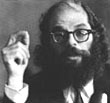Chemical Crusaders
 |
| Allen Ginsberg testifying before the Senate on drug abuse. |
|
In December 1960 Allen Ginsberg and
Peter Orlovsky arrived at Timothy Leary's
house in Newton, MA. Although Ginsberg was a veteran of psychedelic trips, he had
never tried psilocybin, so when the opportunity presented itself he and Orlovsky
jumped at it. The environment provided by Leary was much more congenial than the
research institute in Palo Alto where Ginsberg had taken LSD the previous year. After
swallowmg the mushroom pills, Ginsberg became slightly nauseous, but his initial
queasiness subsided as the drug took command of his being. He and Orlovsky were
completely overwhelmed. They took off their clothes and padded around the house, a
supernatural gleam in their eyes. Ginsberg was inundated by a rush of messianic
feelings. "We're going to teach people to stop hating.... Start a peace and love
movement," he triumphantly proclaimed. Ginsberg had some forthright ideas about what to do with the synthetic mushroom. As far as he was concerned, psilocybin had vast implications far beyond the world of medicine; psychedelic drugs held the promise of changing mankind and ushering in a new millennium and therefore no one had the right to keep them from the average citizen. Whereas Aldous Huxley had suggested turning on opinion leaders, Ginsberg, the quintessential egalitarian, wanted everyone to have the opportunity to take mind-expanding drugs. His plan was to tell everything, to disseminate as much information as possible. The time was ripe to launch a psychedelic crusade--and what better place to start than Harvard University, the alma mater of president-elect John F. Kennedy! Leary seemed ideally suited to lead such a campaign. A respected academic, he had short hair, wore button-down shirts, and took his role as a scientist quite seriously. How ironic, Ginsberg noted, "that the very technology stereotyping our consciousness and desensitizing our perceptions should throw up its own antidote....Given such historic Comedy, who should emerge from Harvard University but the one and only Dr. Leary, a respectable human being, a worldly man faced with the task of a Messiah." Ginsberg pulled out his little black address book and began reeling off the names of people they could turn on: painters, poets, publishers, musicians, and so on. In addition to being one of the most important poets of his time, Ginsberg was a cultural ambassador of sorts. He traveled in various circles, and his contacts were international in scope. He would carry the message to everyone he knew. He retumed to New York armed with a stash of psilocybin. At the Five Spot in Greenwich Village he gave the mushroom pills to Theolonius Monk, the great jazz pianist. A few days later Ginsberg dropped by Monk's apartment to check on the results. Monk peered out from behind a crack in the door, smiled, and asked if he had anything stronger. Ginsberg also turned on Dizzy Gillespie, who was evidently quite pleased by the gesture. "Oh yeah," he laughed, "anything that gets you high." In a sense it was Ginsberg's way of returning a historical favor: the jazz musicians had given marijuana to the beats, and now the beats were turning the iazz cats on to psychedelics. Word of the new drugs spread quickly through the jazz scene, and numerous musicians, including many of the preeminent players in the field, experimented with psychedelics in the early l960s. John Coltrane, the acknowledged master of the tenor saxophone, took LSD and reported upon returning from his inner voyage that he "perceived the inter-relationship of all life forms." |
An excerpt from Acid Dreams: The Complete Social History of
LSD: The CIA, the Sixties and Beyond, by Martin A. Lee and Bruce Shlain
(Grove Press)
Copyright 1985 by Martin A. Lee and Bruce Shlain
The Acid Dreams web site: http://www.levity.com/aciddreams/